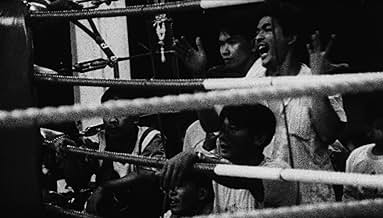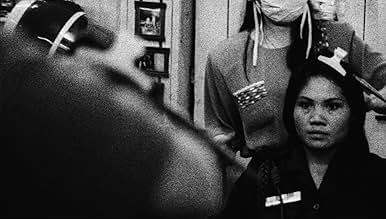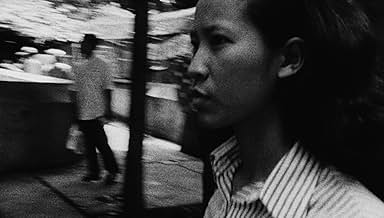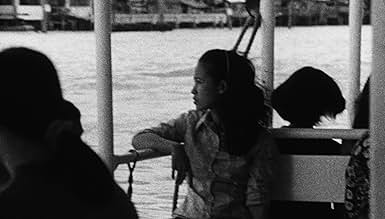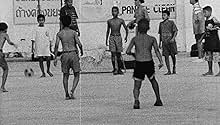IMDb RATING
6.7/10
1.9K
YOUR RATING
A film crew documents a folk story-exquisite corpse combination by random Thai people; the story is reenacted.A film crew documents a folk story-exquisite corpse combination by random Thai people; the story is reenacted.A film crew documents a folk story-exquisite corpse combination by random Thai people; the story is reenacted.
- Awards
- 4 wins & 4 nominations total
Featured reviews
The idea of "Exquisite Corpse" has always fascinated me, and I'm happy that there's a movie based around such a unique method of story-telling. The director comments that by the end, it was less about the actual story the villagers were telling and more about the social implications; therefore the movie becomes more of a documentary. I enjoyed this movie but would like to see more movies based on the Exquisite Corpse method, possibly one part going "out into the field" and talking to villagers, gathering the story, and then a second part where either a rehearsed play or actual movie was written given those elements. Mysterious Object at Noon gets an A- from me.
This approaches art, and does so from an oblique angle and in an exotic locale. That being said for me, it never achieves that art., Despite the loose effort to stitch a thread of a story through this, and some curious disjointed elements, the whole does not hold.
See this film if you are willing to bring a lot to the party. (And kudos to you, davidals@msn.com) Or play it in your rental store, or during a party with the sound off, and it will probably snare more fish than it does standing alone with you and your remote.
I'm all for experimental film, this could have been whittled down to a 7 minute beauty for the Ann Arbor Film Fest; at 83 min, it came across as a chore, a corpse less than exquisite. And while I'm coming across as the anti-hipster, why black (or almost a dusty brown) and white for this film? Color I think would have made this more florid and captivating, although perhaps more common-place and thus undermined the art?
Wait till your film professor assigns this one to you.
3/10
See this film if you are willing to bring a lot to the party. (And kudos to you, davidals@msn.com) Or play it in your rental store, or during a party with the sound off, and it will probably snare more fish than it does standing alone with you and your remote.
I'm all for experimental film, this could have been whittled down to a 7 minute beauty for the Ann Arbor Film Fest; at 83 min, it came across as a chore, a corpse less than exquisite. And while I'm coming across as the anti-hipster, why black (or almost a dusty brown) and white for this film? Color I think would have made this more florid and captivating, although perhaps more common-place and thus undermined the art?
Wait till your film professor assigns this one to you.
3/10
Director Apichatpong Weerasethakul went around Thailand with a film crew for three years, having what seem to be random people tell a round-robin story. One person would tell one part, then on to the next. It's a technique I've seen used in a couple of amateur-press stories from the 1930s, when professional science fiction writers were cheap -- the line was that WONDER STORIES offered a quarter cent per word, payable upon lawsuit. One writer would start the story, another would continue for a few pages, and so forth.
As a story-telling movie, it's .... well, it's an interesting experiment that does not work. The writers in the 1930s round-robin stories were pros, who understood how plotting worked and how far they could veer. With this one, we watch people do a hard left on the story, argue about what has been been decided earlier in the story. It's less like the way in LOVE ME TONIGHT, the song "Isn't It Romantic?" wafts from Paris to a distant castle, changing to various tempi along the way, and more like the way my great-aunt Esther would tell a story. She would drone on for about thirty minutes, pause to make sure I understood some point -- "...so they had to find the money for the rent. If they didn't pay the rent, they could be out on the street, you know what I mean?" After I would tiredly admit that I understood eviction, she would continue with "So once I knew this guy, I think I met him through my friend Rosie from high school, he had a picture of Rutherford B. Hayes on his kitchen wall next to the electric clock." Then she would talk about the clock for half an hour. Not that there was anything interesting about the clock; had there been, I think, she would never have mentioned it at all.
That's what the story-telling in this reminds me of. Oh, the people are trying to tell a good story, but they lack the training.
What I think this movie works as is a city-symphony picture, one of those movies in the 1920s and 1930s which purported to show you Berlin in BERLIN, SYMPHONY OF A GREAT CITY or New York in MANHATTA. I think it works better as that, although it's less about the city and the countryside, their institutions and rhythms, than individuals.
As a story-telling movie, it's .... well, it's an interesting experiment that does not work. The writers in the 1930s round-robin stories were pros, who understood how plotting worked and how far they could veer. With this one, we watch people do a hard left on the story, argue about what has been been decided earlier in the story. It's less like the way in LOVE ME TONIGHT, the song "Isn't It Romantic?" wafts from Paris to a distant castle, changing to various tempi along the way, and more like the way my great-aunt Esther would tell a story. She would drone on for about thirty minutes, pause to make sure I understood some point -- "...so they had to find the money for the rent. If they didn't pay the rent, they could be out on the street, you know what I mean?" After I would tiredly admit that I understood eviction, she would continue with "So once I knew this guy, I think I met him through my friend Rosie from high school, he had a picture of Rutherford B. Hayes on his kitchen wall next to the electric clock." Then she would talk about the clock for half an hour. Not that there was anything interesting about the clock; had there been, I think, she would never have mentioned it at all.
That's what the story-telling in this reminds me of. Oh, the people are trying to tell a good story, but they lack the training.
What I think this movie works as is a city-symphony picture, one of those movies in the 1920s and 1930s which purported to show you Berlin in BERLIN, SYMPHONY OF A GREAT CITY or New York in MANHATTA. I think it works better as that, although it's less about the city and the countryside, their institutions and rhythms, than individuals.
A camera attached to a moving car takes us down a busy city street in Thailand. Abruptly, the car turns into a narrow alley where we see brush grass and run down shacks. As the camera enters one of the houses, a heavy-set woman speaks of the trauma involved in her being sold into prostitution by her father. When she is finished, an off-camera voice asks her to tell another story, real or fiction. It is then that we begin to sense that cinematically we are in unchartered territory. Internationally acclaimed Thai director Apichatpong Weerasethakul's first feature Mysterious Object at Noon is an offbeat mixture of reality and fiction in which there is no screenplay or linear narrative, only a story created and added to by each participant in the mode of the French game "exquisite corpse".
The story the woman first tells is that of a teacher named Dogfahr whose young pupil is a cripple confined to a wheelchair. The tale is then dramatized on screen by non actors alternating with the talking storyteller. As the camera moves north and south of Bangkok into the Thai countryside, a cross section of Thai's continue the story by adding a few lines. These include two deaf girls using sign language, a song and dance troupe, and children in a rural Thai school. With each addition, the tale becomes vastly different and increasingly fantastic. The mysterious object in the title falls from the teacher who has collapsed and turns into an extraterrestrial boy with strange powers, a duplicate teacher, and finally a "witch tiger" and a magic sword.
Some sequences stand by themselves and are without any relation to the continuing storyline. The teacher brings her father to the doctor for a hearing test and complains of a strange line around her neck which the doctor dismisses as an allergy or the effect of wearing her necklace. Parents talk of a boy who escaped death in a plane crash because he was protected by amulets, and a scene shows women bargaining at a fish market. An experimental film with a small budget shot in 16-millimeter black and white, Mysterious Object at Noon glows with warmth and playfulness. As it progresses, it also slows down and becomes more of a meditation on Thai culture, creating a mood of tranquility and peace. Like Seinfeld, it is ostensibly "about nothing", but turns out to be about everything.
The story the woman first tells is that of a teacher named Dogfahr whose young pupil is a cripple confined to a wheelchair. The tale is then dramatized on screen by non actors alternating with the talking storyteller. As the camera moves north and south of Bangkok into the Thai countryside, a cross section of Thai's continue the story by adding a few lines. These include two deaf girls using sign language, a song and dance troupe, and children in a rural Thai school. With each addition, the tale becomes vastly different and increasingly fantastic. The mysterious object in the title falls from the teacher who has collapsed and turns into an extraterrestrial boy with strange powers, a duplicate teacher, and finally a "witch tiger" and a magic sword.
Some sequences stand by themselves and are without any relation to the continuing storyline. The teacher brings her father to the doctor for a hearing test and complains of a strange line around her neck which the doctor dismisses as an allergy or the effect of wearing her necklace. Parents talk of a boy who escaped death in a plane crash because he was protected by amulets, and a scene shows women bargaining at a fish market. An experimental film with a small budget shot in 16-millimeter black and white, Mysterious Object at Noon glows with warmth and playfulness. As it progresses, it also slows down and becomes more of a meditation on Thai culture, creating a mood of tranquility and peace. Like Seinfeld, it is ostensibly "about nothing", but turns out to be about everything.
"Mysterious" held much dramatic promise.
But because of its hybrid innovation, I'm at a lost as to rate it as a dramatic feature or a documentary film. Either way, despite its critical accolades, it wasn't able to interest me enough to wanna cradle its inadequacies. Poor film making craft is inexcusable even if this feature is excusably in a league of its own. (And did anyone catch a moment of Ozu homage in one of the scenes, with children walking by at one end and the camera placed at another? Nice...)
That said, there were undeniable moments of brilliance in it. Two standouts come to mind; The "banter" between the two mute girls and that staged re-enactment by the villagers. And it shown the director to be one who knows how to capture such cinematic sparks, albeit inconsistently.
I thus hope to see "Blissfully yours" before I decide on my regard for Apichatpong Weerasethakul as a film maker. Similarly, "Mysterious" will be given the benefit of the doubt. For honestly, it just didn't hack it for me right now.
But because of its hybrid innovation, I'm at a lost as to rate it as a dramatic feature or a documentary film. Either way, despite its critical accolades, it wasn't able to interest me enough to wanna cradle its inadequacies. Poor film making craft is inexcusable even if this feature is excusably in a league of its own. (And did anyone catch a moment of Ozu homage in one of the scenes, with children walking by at one end and the camera placed at another? Nice...)
That said, there were undeniable moments of brilliance in it. Two standouts come to mind; The "banter" between the two mute girls and that staged re-enactment by the villagers. And it shown the director to be one who knows how to capture such cinematic sparks, albeit inconsistently.
I thus hope to see "Blissfully yours" before I decide on my regard for Apichatpong Weerasethakul as a film maker. Similarly, "Mysterious" will be given the benefit of the doubt. For honestly, it just didn't hack it for me right now.
Did you know
- TriviaFilming was carried out for three years with a volunteer crew, and only stopped when the camera broke down - the last shot of the movie is literally the last piece of film that passed through the camera.
- ConnectionsFeatured in 40 Days to Learn Film (2020)
- How long is Mysterious Object at Noon?Powered by Alexa
Details
- Release date
- Countries of origin
- Languages
- Also known as
- Heavenly Flower in Devil's Hand
- Production companies
- See more company credits at IMDbPro
- Runtime
- 1h 29m(89 min)
- Color
- Sound mix
- Aspect ratio
- 1.37 : 1(original 16mm negative ratio)
Contribute to this page
Suggest an edit or add missing content


